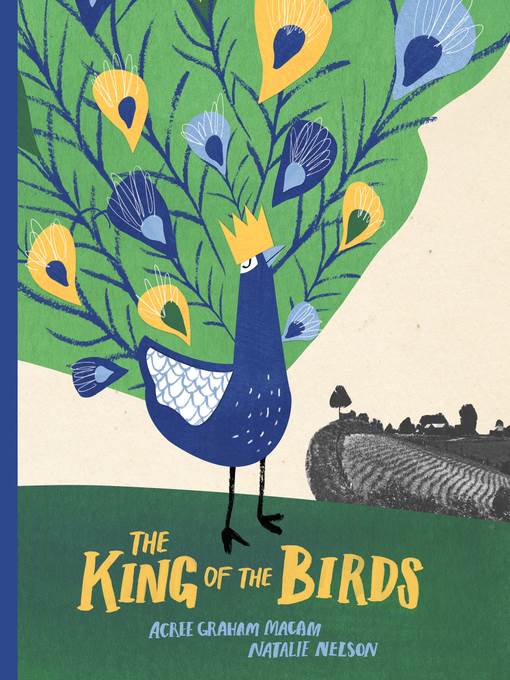
The King of the Birds
فرمت کتاب
ebook
تاریخ انتشار
2016
Lexile Score
540
Reading Level
2-3
نویسنده
Natalie Nelsonناشر
Groundwood Books Ltdشابک
9781554988525
کتاب های مرتبط
- اطلاعات
- نقد و بررسی
- دیدگاه کاربران
نقد و بررسی

July 11, 2016
Flannery, a bespectacled girl in a plaid dress, earns a national newspaper mention with a chicken she trains to walk backward, but her celebrity career ends there. Now, with things “a little too quiet,” she adds a peacock to her yard of fowl, but he won’t display his magnificent tail. “What’s wrong with him?” the boy next door asks. Flannery courts the peacock with a party and flowers, but nothing works. Then she gets a peahen, and that produces results: “With a proud sigh, he raised his tail into an enormous green-gold arch that circled his body like a giant glimmering crown.” Nelson stages the scenes on hand-painted taupe paper with cutout shapes, old prints of speckled hens, photographs of elderly neighbors, and other scrapbook ephemera. In a brief, graceful afterword, Macam and Nelson explain that the story is based on writer Flannery O’Connor, who kept fowl as a child and trained a hen to walk backward. (They note that O’Connor’s work “proved that everybody—even preachers and grandmothers—needs to be forgiven.”) It’s a droll, low-key debut for both author and artist. Ages 4–7.

July 1, 2016
Readers with a taste for the quirky will flock to this tale inspired by Flannery O'Connor's love of peafowl. In rural Georgia, little Flannery trains her chicken to walk backward, earning the duo a few moments in the spotlight and awakening in the child a taste for more excitement. An ever expanding assortment of feathered friends ensues, each individual bird delightfully expressive thanks to Nelson's masterful collage illustrations in muted retro tones. A mail-order peacock is the seemingly inevitable crowning addition to this collection, but his coy reluctance to display his tail feathers demands creative problem-solving on the part of his young mistress. Books for young people about famous individuals whose work they cannot yet appreciate sometimes fall flat; in this case, the unexpected antics of birds and child sustain interest whether O'Connor's name is familiar to readers or not. However, the book would have benefitted from more detailed biographical and source information than the brief concluding note (for example, no mention is made of O'Connor's essay "King of the Birds," which details her avian adventures). Feathered friends of many varieties adorn this charming volume that evokes bygone times of unfettered outdoor play and highlights a little-known episode in the life of a remarkable woman, but the peacock truly rules the roost. (Picture book. 4-7)
COPYRIGHT(2016) Kirkus Reviews, ALL RIGHTS RESERVED.

September 1, 2016
PreS-Gr 2-Flannery enjoys 15 minutes of fame after she teaches her chicken to walk backward and a journalist from New York covers the story. In an attempt to maintain the heightened barnyard mood, the girl adds more birds to her collection. When that effort fails, she purchases a peacock and puts him in charge. Despite attempts to cajole the "king" into displaying his tail-she throws a party, feeds him flowers, and leads a parade-he refuses to oblige. Softly textured tan pages provide a warm backdrop for Nelson's digitally composed scenes, in which black-and-white landscape photographs contrast with the colorful fowl created from painted paper. Deadpan expressions on the birds match the understated storytelling. When a solution presents itself in the form of a peahen and the peacock finally fans his tail, "the queen look[s] down at the ground, interested in some rocks that [are] there." An author's note reveals that the germ of this tale was drawn from the childhood of writer Flannery O'Connor, who later in life also raised peacocks. While this literary anecdote has charm, the book would benefit from stronger narrative elements. It is not clear until several pages in whether Flannery is the child or the chicken. Two conversations with the boy next door don't contribute much. The excitement that Flannery yearns for feels unattained-perhaps a result of birds and girl always wanting more and the moments themselves being presented in an underwhelming manner. VERDICT Interesting as a historical footnote, but it doesn't hold up for repeated readings.-Wendy Lukehart, District of Columbia Public Library
Copyright 2016 School Library Journal, LLC Used with permission.

September 15, 2016
Grades K-2 People may be unfamiliar with the fact that Flannery O'Connor once taught a chicken to walk backward, a feat that got the six-year-old in the news. This provides the inspiration for Macam's whimsical account of young Flannery's bird-filled childhood and her deep desire to own a peacock. Following the thrill of making the news, Flannery began to feel that life was a little too quiet and started collecting a variety of birds to liven up the farm. Soon, all manner of chickens, quail, pheasants, and ducks populate the pages, where Nelson assembles wonderfully unique rustic scenes from hand-painted cut paper and found photography. Things are still too quiet for Flannery's taste, though, until she spots a newspaper ad about a peacock for sale. When the stately bird finally arrives, it struts pompously around the farm but refuses to fan its tail. After many failedyet highly entertainingattempts, Flannery figures out just the thing to coax the peacock to display his plumage. Though fictionalized, this quirky-but-true story is nothing short of charming.(Reprinted with permission of Booklist, copyright 2016, American Library Association.)

























دیدگاه کاربران